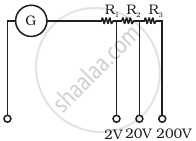Advertisements
Advertisements
Question
Increasing the current sensitivity of a galvanometer may not necessarily increase its voltage sensitivity. Explain, giving reason.
Solution
The current sensitivity of a moving coil galvanometer is given by `(nBA)/k`, where n is the number of turns , A is the area of the coil , B is the magnetic field strength of the poles and k is the spring's constant of the suspension wire.
Similarly, voltage sensitivity is given by `(nBA)/(kR)`, where R is the resistance of the wire.
From the above two expressions, we get:
Voltage sensitivity = Current sensitivity/R
Thus, on increasing the current sensitivity, voltage sensitivity may or may not increase because of similar changes in the resistance of the coil, which may also increase due to increase in temperature.
APPEARS IN
RELATED QUESTIONS
A rectangular coil of a moving coil galvanometer contains 50 turns each having area 12 cm2 . It is suspended in radial magnetic field 0.025 Wb/m2 by a fibre of twist constant 15 x10-10 Nm/degree. Calculate the sensitivity of the moving coil galvanometer.
Write the underlying principle of a moving coil galvanometer.
A galvanometer of resistance G is converted into a voltmeter to measure upto V volts by connecting a resistance R1 in series with the coil. If a resistance R2 is connected in series with it, then it can measures upto V/2 volts. Find the resistance, in terms of R1 and R2, required to be connected to convert it into a voltmeter that can read upto 2 V. Also find the resistance G of the galvanometer in terms of R1 and R2
Outline the necessary steps to convert a galvanometer of resistance RG into an ammeter of a given range ?
A coil of radius 10 cm and resistance 40 Ω has 1000 turns. It is placed with its plane vertical and its axis parallel to the magnetic meridian. The coil is connected to a galvanometer and is rotated about the vertical diameter through an angle of 180°. Find the charge which flows through the galvanometer if the horizontal component of the earth's magnetic field is BH = 3.0 × 10−5 T.
A galvanometer coil has a resistance of 15 Ω and the metre shows full scale deflection for a current of 4 mA. How will you convert the metre into an ammeter of range 0 to 6 A?
In a moving coil galvanometer the deflection (Φ) on the scale by a pointer attached to the spring is ______.
A galvanometer of resistance 100 Ω gives a full-scale deflection for a current of 10−5 A. To convert it into an ammeter capable of measuring up to 1 A we should connect a resistance of ______.
A multirange voltmeter can be constructed by using a galvanometer circuit as shown in figure. We want to construct a voltmeter that can measure 2V, 20V and 200V using a galvanometer of resistance 10Ω and that produces maximum deflection for current of 1 mA. Find R1, R2 and R3 that have to be used.

A galvanometer shows full-scale deflection for current Ig. A resistance R1 is required to convert it into a voltmeter of range (0 - V) and a resistance R2 to convert it into a voltmeter of range (0 - 2V). Find the resistance of the galvanometer.
